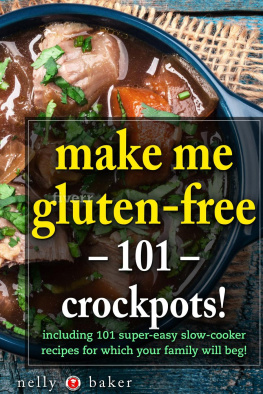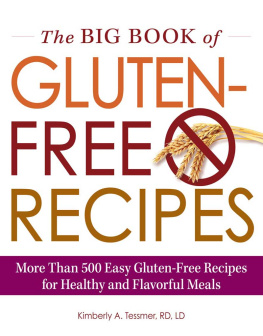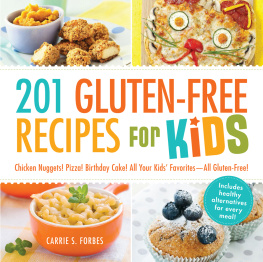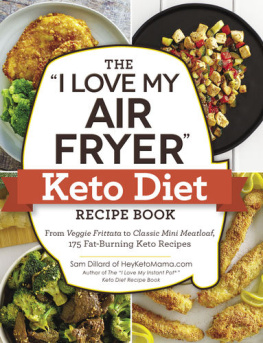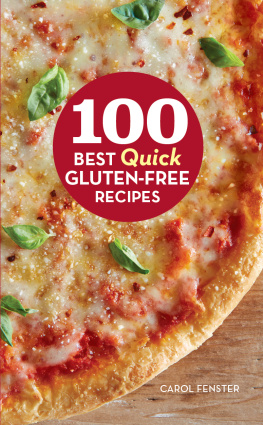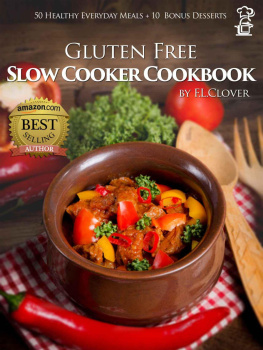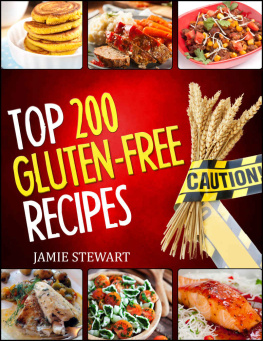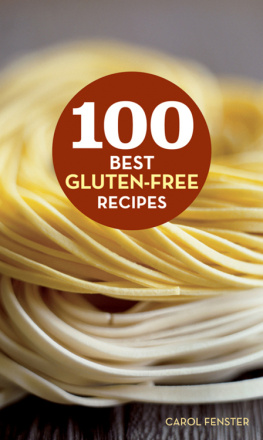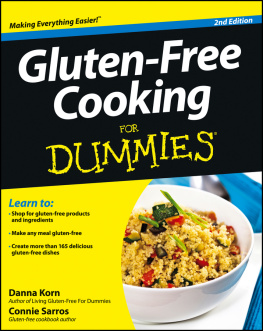W hether you are new to a gluten-free diet and are looking for recipes and menus to get you started, live in the fast lane with little time for cooking, or are just looking to increase your repertoire of go-to gluten-free dishes, this book offers recipes, ideas, and strategies that will make your time in the kitchen, and possibly your life, a little easier.
I love to eat, cook, and entertain. In a perfect world I would possess unlimited time in which I could pursue these endeavors. The sad reality is that I do not live in a perfect world and the demands of work, family, and other obligations consume a huge amount of my time. And I believe I am not alone.
No matter how hectic our daily schedules are, eat we must. And if I must eat, I must eat well. Having a limited amount of time does not mean I want to compromise the quality of what I eat.
Being gluten-free can add to the challenge of preparing quick meals. We do not have the same abundance of convenience foods available to us as the average person. Some may look at this as an inconvenience. However, I see the upside of avoiding the unhealthy chemical additives and highly processed ingredients so often found in prepackaged foods.
It is a terrible thing when a passion starts to feel like drudgery. As much as I love my time spent in the kitchen (with the exception of the cleaning up!) even I can get harried when I have just thirty minutes to feed six people. I never want to resent making a meal as creating and preparing food for people is one of my great passions.
I consider myself somewhat of a lazy person, always looking for time-saversand shortcuts, but ironically I am also a person who tries to cram as many activities into each day as is humanly possible. Given this dichotomy and the fact that I want any project or meal I undertake to be done to the best of my ability, I have learned and developed tips and strategies over the years for preparing delicious, gluten-free meals quickly and easily.
Whether you love to cook or just do it because you have to, my hope is that this book will spark your imagination, give you some guidelines, and serve as a springboard for your own creativity in the kitchen.
I have lived my whole life in areas of the world that tend to be unexpectedly hit by natural disasters, such as earthquakes and hurricanes. So I have learned the value of a well-stocked pantry. But of course life has a way of throwing everyday emergencies at you, and it is at times like that when the pantry can be your saving grace.
Whether you have five minutes or five hours to get food on the table, the pantry is the best place to go shopping. After all, no one wants to run to the store every time they have a meal to prepare.
I consider the freezer, refrigerator, and spice cabinet part of my pantry as well as the actual pantry itself. You might think that as a cookbook writer and recipe developer I would have a huge pantry. Nothing could be further from the truth. Most people have more space in their broom closet than I have in my actual pantry. This being the case, I must choose wisely what I put in it. Here is a list of what I consider the essentials.
Almond Flour. Great for grain-free baking and cooking. Look for finely ground, blanched almond flour. It is available in health food stores and on the Internet. Recently I have started seeing it in regular grocery stores.
Almond Milk. A great dairy-free milk alternative, I use almond milk for baking, adding to cereal, and in desserts. Unopened almond milk containers can be stored in the pantry.
Baking Powder. A leavening agent that helps cakes and breads rise, I use aluminum-free, double-acting baking powder. Corn-free baking powder is also available.
Baking Soda. Used in baking as a leavening agent, it also has a wide variety of other purposes so it earns its place on my pantry shelves.
Brown Rice Flour. I use only superfine as it produces far superior results and is a great way to add whole grains to your gluten-free diet. My favorite brand is Authentic Foods. It is available in natural food stores and on the Internet.
Canned Beans. I love dried beans and always stock them, but unless I have hours to soak and cook them, canned beans are a go-to staple. I stock a variety: black, white, kidney, and chickpeas. They are great for making quick soups, for adding to salads, and for stews and casseroles.
Canned Coconut Milk. Coconut milk is my preferred dairy-free alternative for baking and in making desserts and some sauces. I stock both full fat and low fat. The full-fat milk has a pronounced coconut flavor while in the low-fat version the coconut flavor is much less pronounced.
Canned Fruit. Of course I prefer fresh fruit but I do stock a few cans of my favorite canned fruits such as dark sweet cherries, peaches, pineapple, and mandarin oranges for last-minute desserts and for adding some zing to salads.
Canned Mild Chilies. These not-too-spicy chilies add depth of flavor and a little heat to Latin-inspired dishes.
Canned Tomatoes. Unless tomatoes are in season fresh ones can be tasteless. For soups, stews, and sauces I always keep a stock of canned tomatoes on hand. The tomatoes for canning are picked ripe and canned shortly after, often making them a better choice unless it is the peak of tomato season. I stock both small and large cans and love the San Marzano tomatoes from Italy but I will also buy store-brand cans of diced tomatoes when they are on sale.
Canned Tuna. Great for a quick lunch, mixed with some mayonnaise and veggies and wrapped in a lettuce leaf. I keep both tuna packed in water and in olive oil so I can choose depending on my mood and the number on my bathroom scale.
Chipotles in Adobo Sauce. Smoked jalapeo peppers in red sauce can add smoky depth of flavor to dishes as well as heat. They come in small cans andare sold in the ethnic section of the grocery store. I rarely use a whole can in one recipe so I open the can, pour the contents in the blender, puree, and store in a small jar in the fridge; this way I can use just as much as I need for any given recipe. I add it to mayonnaise or stir it into sauces, stews, and even salad dressings.
Chocolate. I keep bags of good-quality bittersweet and semisweet chocolate chips on hand at all times. Stay away from inexpensive store brands as they often contain wax fillers. In my world, chocolate is an essential.
Condiments. With a good stock of condiments you can whip up a tasty meal with little thought or planning. I am never without ketchup, hot pepper sauce, such as Tabasco, chili garlic paste, gluten-free soy sauce, fish sauce, a variety of mustards, A.1. Steak Sauce, gluten-free taco sauce, Worcestershire sauce, and jarred salsa. Jams and jellies are a must as well. See note above under mayonnaise about cross contamination.
Cornstarch. Good for thickening soups, sauces, and gravies. If you are intolerant to corn, use tapioca starch or arrowroot powder instead.
Dried Fruit. It is great to keep a variety of your favorites on hand not just for snacking but for sprucing up salads, baking, and adding variety to stews. You can typically find cherries, cranberries, apricots, and dates in my pantry. I use dates in baking and cooking as a natural sugar substitute.
Dried Gluten-Free Pasta. After much trial and error I finally found a brand of dried gluten-free pasta I like, Tinkyada. It comes in both white and brown rice varieties and in various shapes. You may find you prefer a different brand but whatever kind you like, it is always a good idea to have a few bags for when you need a quick go-to meal.



